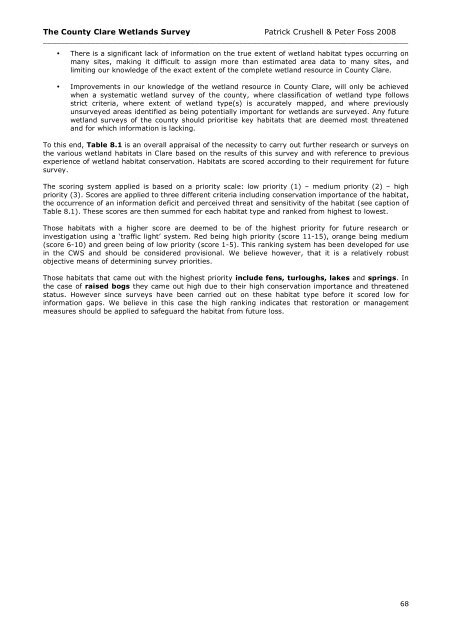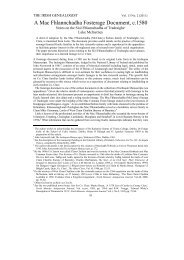Report Cover Vol I - Clare County Library
Report Cover Vol I - Clare County Library
Report Cover Vol I - Clare County Library
Create successful ePaper yourself
Turn your PDF publications into a flip-book with our unique Google optimized e-Paper software.
The <strong>County</strong> <strong>Clare</strong> Wetlands Survey Patrick Crushell & Peter Foss 2008<br />
____________________________________________________________________________________<br />
• There is a significant lack of information on the true extent of wetland habitat types occurring on<br />
many sites, making it difficult to assign more than estimated area data to many sites, and<br />
limiting our knowledge of the exact extent of the complete wetland resource in <strong>County</strong> <strong>Clare</strong>.<br />
• Improvements in our knowledge of the wetland resource in <strong>County</strong> <strong>Clare</strong>, will only be achieved<br />
when a systematic wetland survey of the county, where classification of wetland type follows<br />
strict criteria, where extent of wetland type(s) is accurately mapped, and where previously<br />
unsurveyed areas identified as being potentially important for wetlands are surveyed. Any future<br />
wetland surveys of the county should prioritise key habitats that are deemed most threatened<br />
and for which information is lacking.<br />
To this end, Table 8.1 is an overall appraisal of the necessity to carry out further research or surveys on<br />
the various wetland habitats in <strong>Clare</strong> based on the results of this survey and with reference to previous<br />
experience of wetland habitat conservation. Habitats are scored according to their requirement for future<br />
survey.<br />
The scoring system applied is based on a priority scale: low priority (1) – medium priority (2) – high<br />
priority (3). Scores are applied to three different criteria including conservation importance of the habitat,<br />
the occurrence of an information deficit and perceived threat and sensitivity of the habitat (see caption of<br />
Table 8.1). These scores are then summed for each habitat type and ranked from highest to lowest.<br />
Those habitats with a higher score are deemed to be of the highest priority for future research or<br />
investigation using a ‘traffic light’ system. Red being high priority (score 11-15), orange being medium<br />
(score 6-10) and green being of low priority (score 1-5). This ranking system has been developed for use<br />
in the CWS and should be considered provisional. We believe however, that it is a relatively robust<br />
objective means of determining survey priorities.<br />
Those habitats that came out with the highest priority include fens, turloughs, lakes and springs. In<br />
the case of raised bogs they came out high due to their high conservation importance and threatened<br />
status. However since surveys have been carried out on these habitat type before it scored low for<br />
information gaps. We believe in this case the high ranking indicates that restoration or management<br />
measures should be applied to safeguard the habitat from future loss.<br />
68
















